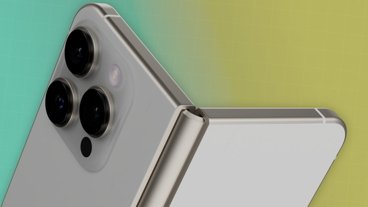Apple is working on technology to allow iPhones or iPads with flexible screens to detect when dropped, and immediately fold up on the way to the ground to minimize damage.
Apple has long been researching foldable devices such as an iPhone or iPad, and has also looked at rollable screens. Each has the intention of presenting a larger display on a small device, but both can result in a screen that is potentially vulnerable to damage.
A newly-revealed patent application called "Self-Retracting Display Device And Techniques For Protecting Screen Using Drop Detection," describes ways of protecting such devices.
Whether the device folds at a hinge, or a screen can be pulled out of a base chassis, Apple proposes that the display itself can choose to break away. Instead of a possibly delicate hinge, or a fragile connection to the device, the display can detach, or fold in such a way that the screen is protected.
Specifically, it could do this when it detects the need. Which means when it detects that the device has been dropped.
 The patent concentrates on how to react to drops, but does include drawings of various types of folding device
The patent concentrates on how to react to drops, but does include drawings of various types of folding device"Mobile devices with foldable and rollable displays can use a sensor to detect vertical acceleration (e.g., acceleration with respect to the ground) to determine if the mobile device has been dropped," says the patent application. "If the sensor detects that the mobile device has been dropped... the foldable device can retract at least partially to afford protection from the fragile display from striking the ground."
There are then two options — retracting the screen, or releasing it.
"[For example, the process] can include activating a release mechanism for a hinged connection between a first display and a second display of the electronic device when the vertical acceleration exceeds a predetermined threshold," continues Apple, "wherein the activating reduces an angle between the first display and the second display below a threshold angle."
That proposal would clearly fit a folding iPad or iPhone where there are really two devices connected by a hinge. If that isn't possible with a specific device, Apple says it could fold the display back.
"Even folding the display to an angle less the 180 degrees can afford some protection," it says, "because the mobile device can strike edges of the mobile device instead of the display itself."
Then lastly, "a rollable device can retract the display if predetermined acceleration limits are exceeded."
This all depends, of course, on how fast the device can register a fall. It also obviously depends how high it's dropped from. So there can never be total protection against drops, but these proposals would help with foldable and rollable devices, which are necessarily more fragile than regular ones.
This patent application is credited to two inventors, Hoon Sik Kim and Michael B. Wittenberg. Both have previously worked on details for a folding iPhone, including the use of geared hinges in it.
 William Gallagher
William Gallagher


-m.jpg)







 Thomas Sibilly
Thomas Sibilly
 Andrew O'Hara
Andrew O'Hara
 Amber Neely
Amber Neely
 Marko Zivkovic
Marko Zivkovic
 Malcolm Owen
Malcolm Owen
 William Gallagher and Mike Wuerthele
William Gallagher and Mike Wuerthele










10 Comments
So would it mechanically close? It’s not clear.
Nice patent to make coin from when the foldable people implement it.
Just keep making non-foldable phones and I’ll trust the case makers to protect them for me.
Iirc there have been convertible automobiles who do something similar; detect a rollover and snap up a roll bar to better protect the passengers. Mercedes?
In other uses, placing it on the floor with a piece of cheese on it makes it the proverbial ‘better mouse trap’ (and the most expensive). :D